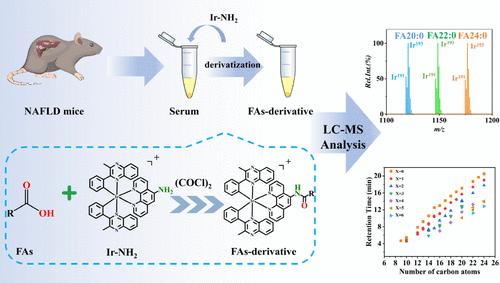非酒精性脂肪肝小鼠非挥发性血清脂肪酸的铱同位素标记辅助LC-MS全局分析和定量方法
IF 6.7
1区 化学
Q1 CHEMISTRY, ANALYTICAL
引用次数: 0
摘要
生物样品中脂肪酸(FAs)的高度精确和灵敏的测量对于提高我们对其多种生物功能的理解是必不可少的。本文基于铱(191/193Ir)的特征同位素谱图,采用铱编码胺(Ir-NH2)作为衍生化试剂,建立了一种选择性灵敏的液相色谱-质谱(LC-MS)方法,用于生物样品中FAs的快速鉴定和准确定量。衍生化后,非挥发性FAs转化为带有带电铱标签的酰胺衍生物,在电喷雾电离(ESI)正离子模式下表现出更高的灵敏度和选择性。利用天然191Ir和193Ir同位素独特的2.002 Da质量位移和3:5的峰强度比,我们可以快速有效地筛选生物样品中潜在的含羧基代谢物。与其他现有方法相比,该技术具有更高的灵敏度,更好的信噪比,更低的检出限(1.2-8.4 pg/mL),并且由于可以清晰地识别铱标记的衍生物,因此更容易定量。通过该方法,在小鼠血清脂质提取物中共检测到58种FAs,包括饱和型和不饱和型,碳链长度从C9到C24不等。更重要的是,该方法成功地用于非酒精性脂肪性肝病(NAFLD)小鼠非挥发性血清FAs的全局分析,为检测它们提供了一种新的手段,并为探索它们的功能作用和疾病关联提供了新的途径。本文章由计算机程序翻译,如有差异,请以英文原文为准。

Iridium Isotope Tag-Assisted LC-MS Method for Global Profiling and Quantification of Nonvolatile Serum Fatty Acids in Nonalcoholic Fatty Liver Mice
Highly accurate and sensitive measurements of fatty acids (FAs) in biological samples are essential for advancing our understanding of their diverse biofunctions. In this work, based on the characteristic isotope pattern of iridium (191/193Ir), we employed an iridium-encoded amine (Ir-NH2) as the derivatization reagent to establish a selective and sensitive liquid chromatography–mass spectrometry (LC-MS) method for rapid identification and accurate quantification of FAs in biological samples. Upon derivatization, nonvolatile FAs were transformed into amide derivatives tagged with a charged iridium tag, exhibiting improved sensitivity and selectivity in the electrospray ionization (ESI) positive ion mode. By leveraging the unique 2.002 Da mass shift and the 3:5 peak intensity ratio from the natural 191Ir and 193Ir isotopes, we can rapidly and efficiently screen the potential carboxyl-containing metabolites from biological samples. Compared to other existing methods, our technique offers higher sensitivity, better signal-to-noise ratio, lower detection limit (1.2–8.4 pg/mL), and easier quantification due to the clear identification of iridium-tagged derivatives. With this method, a total of 58 FAs, including both saturated and unsaturated types, were detected in mice serum lipid extracts, with carbon chain lengths varying from C9 to C24. More importantly, this method was successfully employed for global profiling of nonvolatile serum FAs from mice with nonalcoholic fatty liver disease (NAFLD), providing a novel means for detecting them and offering new avenues for exploring their functional roles and disease associations.
求助全文
通过发布文献求助,成功后即可免费获取论文全文。
去求助
来源期刊

Analytical Chemistry
化学-分析化学
CiteScore
12.10
自引率
12.20%
发文量
1949
审稿时长
1.4 months
期刊介绍:
Analytical Chemistry, a peer-reviewed research journal, focuses on disseminating new and original knowledge across all branches of analytical chemistry. Fundamental articles may explore general principles of chemical measurement science and need not directly address existing or potential analytical methodology. They can be entirely theoretical or report experimental results. Contributions may cover various phases of analytical operations, including sampling, bioanalysis, electrochemistry, mass spectrometry, microscale and nanoscale systems, environmental analysis, separations, spectroscopy, chemical reactions and selectivity, instrumentation, imaging, surface analysis, and data processing. Papers discussing known analytical methods should present a significant, original application of the method, a notable improvement, or results on an important analyte.
 求助内容:
求助内容: 应助结果提醒方式:
应助结果提醒方式:


